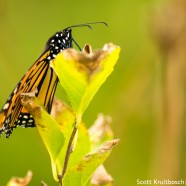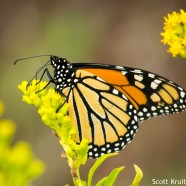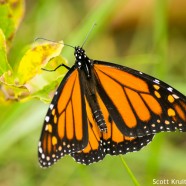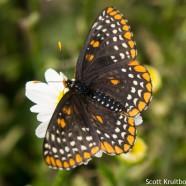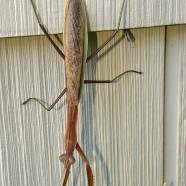Resting Monarch
This Monarch butterfly was content to take a rest out of the wind for a while. Part of what must make a Monarch’s migration so difficult is that autumn days with warm temperatures are often those that feature a strong southerly flow – precisely the opposite of the direction they’d like. Finding sunny and warm days with a tailwind out of the north is not easy in September or October, especially in the Chautauqua-Allegheny region with lake effect clouds and precipitation even under high pressure. This is before we mention the cool temperatures associated with those...
Read MoreMonarch on goldenrod
This Monarch was feeding on goldenrod right on the edge of the coastal bluff, being whipped back and forth by the steady breeze and occasionally strong gusts of wind. It is impressive to see how well they can hang on, keeping a low profile and closed wings to prevent being literally blown away. Those beautiful black and orange sails are useful but could be potentially dangerous if not managed correctly!
Read MoreMigrant Monarch
Today I was thrilled to see several dozen Monarch butterflies as I surveyed a classic fall migration spot on the Connecticut coast. While this total may far under historic sums seen there it is still better than the last couple of years. This male, sexed by the black patches on the hind wings, was one of the more cooperatives individuals. I’ll share more photos of them all week. What are your Monarch counts looking like? Scott Kruitbosch Conservation & Outreach Coordinator
Read MoreHalloween butterfly
The Baltimore Checkerspot (Euphydryas phaeton) will not be seen again until next year but it has such bold and seasonal colors, doesn’t it? This butterfly was built for Halloween. Every part of it has some orange and black to show off! This individual was in the gardens at RTPI in July.
Read MoreMantis above Pachysandra
Here’s a Chinese Mantis hanging out while looking for a snack above a Pachysandra species a few hours ago on this cool September morning. The European Mantis is actually the official state insect of Connecticut despite the fact it is a non-native species. This is supposedly because, “mantis are beneficial insects for farmers and are therefore symbolic reminders of the importance of the natural environment to human and biological survival” according to the CT DEEP website. That is a confounding statement/explanation to me. Maybe we could try something else – the...
Read More



